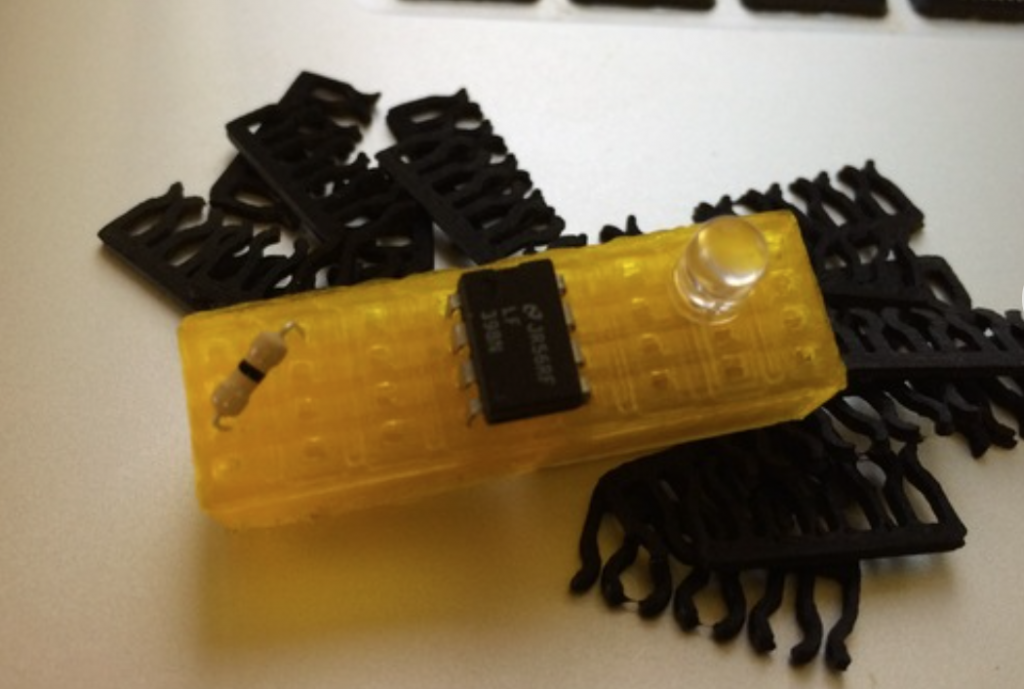 Breadboard is the name given to the construction base used when prototyping electronics. The name is derived from historical usage of an actual kitchen bread board (the board upon which bread was sliced), the kind of thing you can imagine young mad scientists stealing from her/his mother’s kitchen. The board would be laden with tubes, wires, and things with names such as ‘interferometer’ in efforts to travel through time or just to create a better radio.
Breadboard is the name given to the construction base used when prototyping electronics. The name is derived from historical usage of an actual kitchen bread board (the board upon which bread was sliced), the kind of thing you can imagine young mad scientists stealing from her/his mother’s kitchen. The board would be laden with tubes, wires, and things with names such as ‘interferometer’ in efforts to travel through time or just to create a better radio.
Rather than stealing the bread board from the kitchen, and thereby depriving himself of thickly sliced French toast, Les Hall decided to work with 3D printing to create his breadboard. Hall explained his lifelong connection with the platforms:
“I have been working on breadboards for school, work, and fun for all of my adult life, which means 30 years now. I have developed a wiring method for breadboards called ‘the neat freak technique’, and now I have created a technique for 3D printing breadboards.”
 It’s hard not to get caught up in Hall’s enthusiasm. I have to admit that I had never previously considered that my life might be missing a breadboard, but by the end of our interview, I was pretty sure I needed to sell my belongings and dedicate myself to their creation.
It’s hard not to get caught up in Hall’s enthusiasm. I have to admit that I had never previously considered that my life might be missing a breadboard, but by the end of our interview, I was pretty sure I needed to sell my belongings and dedicate myself to their creation.
“Why is this cool? Well breadboards are flat, boring things. You can hook them up and make even bigger flat things. They have adhesive backing for securing them to a metal panel and that’s flat too. With 3D printing, however, we can make breadboards in any desired shape or size! They can be formed into the shape of an aeroplane fuselage or a robot car’s body, melding structure with electronics. They can cover a company logo in 3D with circuitry, they can interconnect 1,000 microcontrollers into an air cooled 3D compute array, with the air ducting morphed into the breadboard structure.”
 Add to this the ability to 3D print with conductive graphene filament and you are really getting into the kind of territory that lights up the eyes of electronics geeks everywhere. Hall’s boards are created with printed grabbers and every other horizontal hole position creates an extra space for those grabbers, the ones that are rotated 90 degrees are rearranged and the end result is a board that operates as if it is nearly twice as wide as it is long.
Add to this the ability to 3D print with conductive graphene filament and you are really getting into the kind of territory that lights up the eyes of electronics geeks everywhere. Hall’s boards are created with printed grabbers and every other horizontal hole position creates an extra space for those grabbers, the ones that are rotated 90 degrees are rearranged and the end result is a board that operates as if it is nearly twice as wide as it is long.
“On a more basic level 3D printed breadboards can be any width and length with different sized holes for accepting different sized or spaced parts like audio jacks or switches for example. It’s cliche, I know, but the possibilities are endless.”
Now, I have to go get myself some French toast.
Subscribe to Our Email Newsletter
Stay up-to-date on all the latest news from the 3D printing industry and receive information and offers from third party vendors.
You May Also Like
NSF Awards Kentucky $1M for Advanced Manufacturing
The National Science Foundation has awarded a $1 million grant to the University of Louisville for the Advancing Manufacturing and Building Construction Technologies (NSF AMT) project. This initiative is part...
3D Printing News Briefs, May 11, 2024: 3D Printed Stent, Tower, Sculptures, & More
We’re starting off with medical research in today’s 3D Printing News Briefs, as researchers in Korea used CT images and 3D printing to fabricate an educational simulator for a mastoidectomy....
3D Printing Unpeeled: Wind Turbines, Probiotics and Lenses
TPI Composites, ORNL and Ingersoll Rand are working to make wind turbine tooling segments that can be 18.3 meters long. These elements also include resistive wires that help keep the...
Tethon 3D Releases Cost-effective Bioprinter
Tethon 3D, known for its ceramic-loaded DLP materials, custom resins, and DLP 3D printers, has recently released a bioprinter. Vat polymerization printers like DLP systems have been widely used by...
































